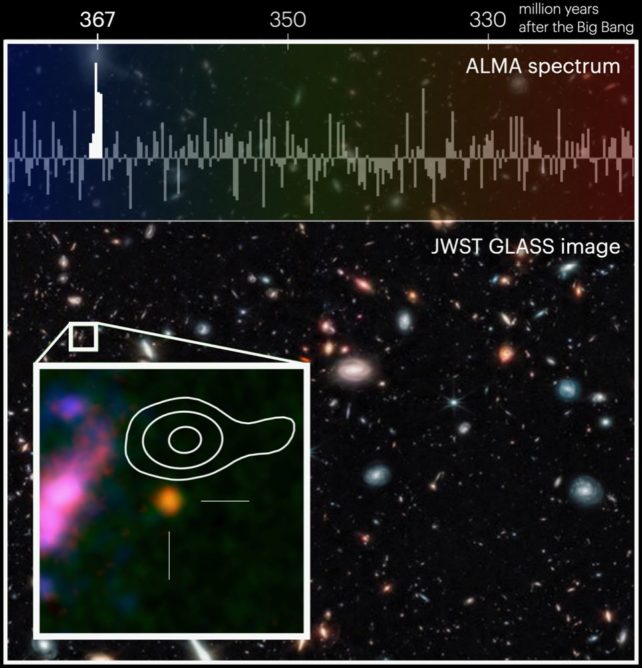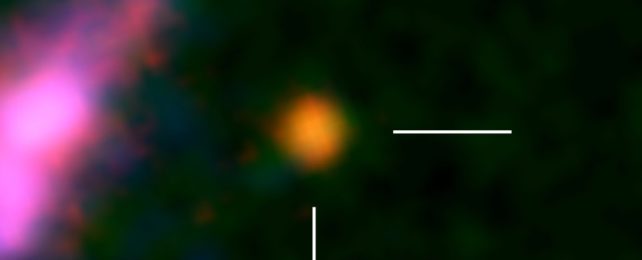A galaxy whose light has traveled nearly 13.5 billion years to reach us has just been confirmed as the earliest galaxy found to date.
By studying the oxygen content of the galaxy with the Atacama Large Millimeter/submillimeter Array (ALMA), astronomers have precisely dated it to just 367 million years after the Big Bang, a time when the first lights in the Universe were still switching on and starting to propagate freely through space.
The result confirms observations made by JWST, and offers new information about the early Universe that tells us about the origins of the elements.
"The first images of the James Webb Space Telescope revealed so many early galaxies that we felt we had to test its results using the best observatory on Earth," says astronomer Tom Bakx of Nagoya University in Japan.
"It was a very exciting time to be an observational astronomer, and we could track the status of the observations that will test the JWST results in real time."
The galaxy, named GHZ2/GLASS-z12, was first spotted by JWST in July of last year, not long after the telescope opened its segmented golden eye on the infrared light of the Universe.
A paper in November detailed the discovery, dating the galaxy back to approximately 350 million years after the Big Bang, which took place around 13.8 billion years ago.
That's actually pretty amazing, but any astronomical discovery is significantly more robust if it can be confirmed using an independent instrument.
So a team led by Bakx and astronomer Jorge Zavala of the National Astronomical Observatory of Japan turned to radio telescope ALMA to see what more they could learn about the fledgling galaxy.
They turned ALMA to the direction of GHZ2/GLASS-z12 and started looking for an emission signature on the radio spectrum associated with oxygen.
Since oxygen takes a relatively short time to form, it's commonly used to learn more about galaxies in the early Universe. And when light enters oxygen, it is re-emitted at a specific wavelength range, resulting in a brighter line on that part of the spectrum.

Each of the 66 12-meter radio antennae that make up ALMA were put to work, ultimately detecting an oxygen emission line close to the position of GHZ2/GLASS-z12. Follow-up analyses and statistical tests determined that the signal was real, and related to the galaxy.
"We were initially concerned about the slight variation in position between the detected oxygen emission line and the galaxy seen by Webb," Bakx explains.
"But we performed detailed tests on the observations to confirm that this really is a robust detection, and it is very difficult to explain through any other interpretation."
The very slight distance between the galaxy and the oxygen emission could suggest that violent explosions or interactions stripped the galaxy of a great deal of its gas, blowing it out into intergalactic space.
The team dated their observations to a more precise 367 million years after the Big Bang. And, based on the brightness of the emission line, they were able to infer that the galaxy had relatively quickly formed high abundances of elements heavier than hydrogen and helium.
This is very interesting. The early Universe, before stars came along, was mostly made up of hydrogen with a smaller amount of helium. Then stars formed; in their hot, dense cores, they started smashing atoms together, creating heavier elements.
But these elements were locked inside the stars; it wasn't until the stars had died, exploding in spectacular supernovae, that heavier elements were able to spread through interstellar space.
This presence of oxygen so early in the Universe gives us some clues about the timing and evolution of these first stars, which we have yet to see directly.
"These deep ALMA observations provide robust evidence of the existence of galaxies within the first few hundred million years after the Big Bang, and confirms the surprising results from the Webb observations," Zavala says.
"The work of JWST has only just begun, but we are already adjusting our models of how galaxies form in the early Universe to match these observations. The combined power of Webb and the radio telescope array ALMA give us the confidence to push our cosmic horizons ever closer to the dawn of the Universe."
The research has been published in the Monthly Notices of the Royal Astronomical Society.
